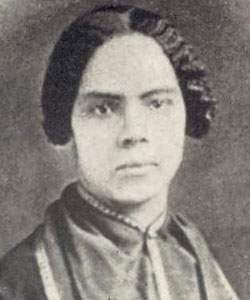Mary Ann Shadd, family and early life (American National Biography)
Scholarship
Although the eldest of thirteen children, Mary Ann Shadd grew up in comfortable economic circumstances. Little is known about her mother except that she was born in North Carolina in 1806 and was of mixed black and white heritage; whether she was born free or a slave is unknown. Shadd's father was also of mixed-race heritage. His paternal grandfather, Jeremiah Schadd, was a German soldier who had fought in the American Revolution and later married Elizabeth Jackson, a free black woman from Pennsylvania. Abraham Shadd had amassed his wealth as a shoemaker, and his property by the 1830s was valued at $5,000. He was a respected member of the free black community in Wilmington and in West Chester, Pennsylvania, where the family had moved sometime in the 1830s, and he served as a delegate to the American Anti-Slavery Society in 1835 and 1836.
Shirley J. Yee "Cary, Mary Ann Camberton Shadd," American National Biography Online, February 2000, http://www.anb.org/articles/09/09-00875.html.
Mary Ann Shadd, abolitionism (American National Biography)
Scholarship
Mary Ann Shadd continued her family's activist tradition by devoting her life to the advancement of black education and the immediate abolition of slavery. As a youth she attended a private Quaker school for blacks taught by whites, in which several of her teachers were abolitionists. During the 1840s she taught in schools for blacks in Wilmington, West Chester, New York City, and Norristown, Pennsylvania. When passage of the Fugitive Slave Act of 1850 endangered the freedom of free blacks as well as fugitive slaves, Shadd joined the faction of black abolitionists who promoted the controversial cause of voluntary black emigration to Canada. This movement illustrated the depth of disillusionment with the United States that had developed among many blacks since the 1840s. Angered and disappointed in the continued tolerance of slavery and the upsurge of violence against free blacks, a faction of black activists broke from the American abolitionist organization and from those black abolitionists who preferred to stay and fight oppression in the United States.
Between 1850 and 1860 approximately 40,000 blacks fled to southern Ontario. Shadd found employment in 1851 as a teacher of blacks in Windsor, Ontario, and was later joined by several members of her family. Shadd taught school and became a fervent spokeswoman for the emigration movement. Like most teachers in the black settlements, she had to struggle to keep her schools open, facing such obstacles as inadequate supplies, ramshackle school buildings, inclement weather, and the frequent outbreak of cholera and measles.
Shirley J. Yee "Cary, Mary Ann Camberton Shadd," American National Biography Online, February 2000, http://www.anb.org/articles/09/09-00875.html.
Mary Ann Shadd, Civil War and women's rights (American National Biography)
Scholarship
During the Civil War she traveled to the United States to help recruit soldiers for the Union army. In 1869, Mary Ann Shadd Cary, by now a widow, moved to Washington, D.C., with her two children. Later, she lived with her older daughter, Sarah E. Cary Evans, a schoolteacher. Between 1869 and 1871 she began her studies in law at Howard University but stopped for unknown reasons. She resumed her studies in 1881 and received her degree in 1883, the only black woman in a class of five, although there is no evidence that she actually practiced law. She also continued her support for women's rights. In 1878 she delivered a lecture at the annual National Woman Suffrage Association Conference. She died at home in Washington.
Mary Ann Shadd Cary stands as one of the most significant, yet least recognized, abolitionists who worked on behalf of black emigration and the sustenance of black settlements in Canada. At the same time, her lifelong challenge of racism and sexism made Cary an important figure in the struggle for racial and sexual equality during the nineteenth century.
Shirley J. Yee "Cary, Mary Ann Camberton Shadd," American National Biography Online, February 2000, http://www.anb.org/articles/09/09-00875.html.


